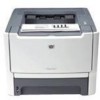HP P2015 Service Manual - Page 19
Paper, Labels, Label construction, Transparencies, Envelopes, CAUTION - laserjet fuser
 |
UPC - 882780491984
View all HP P2015 manuals
Add to My Manuals
Save this manual to your list of manuals |
Page 19 highlights
● Do not use paper that is embossed or coated and is not designed for the temperatures of the printer's image fuser. Select media that can tolerate temperatures of 200°C (392°F) for 0.1 second. HP produces a selection of media that is designed for the HP LaserJet P2015 Series printers. ● Do not use letterhead paper that uses low temperature dyes or thermography. Preprinted forms or letterhead must use inks that can tolerate temperatures of 200°C (392°F) for 0.1 second. ● Do not use any media that produces hazardous emissions, or that melts, offsets, or discolors when exposed to temperatures of 200°C (392°F) for 0.1 second. To order HP LaserJet printing supplies, go to http://www.hp.com/go/ljsupplies/ in the U.S. or to http://www.hp.com/ghp/buyonline.html/ worldwide. Paper For best results, use conventional 75 g/m2 (20 lb) paper. Make sure that the paper is of good quality and free of cuts, nicks, tears, spots, loose particles, dust, wrinkles, voids, and curled or bent edges. Labels Print labels from tray 1 by using the straight-through output path. CAUTION Do not feed a sheet of labels through the printer more than once. The adhesive degrades during the heat of printing and might damage the printer. Label construction When selecting labels, consider the quality of the following components: ● Adhesives: The adhesive material should be stable at 200°C (392°F), the printer's maximum temperature. ● Arrangement: Only use labels with no exposed backing between them. Labels can peel off sheets that have spaces between the labels, causing serious jams. ● Curl: Prior to printing, labels must lie flat with no more than 13 mm (0.5 inch) of curl in any direction. ● Condition: Do not use labels that have wrinkles, bubbles, or other indications of separation. Transparencies Transparencies must be able to withstand 200°C (392°F), the printer's maximum temperature. Envelopes Print envelopes from tray 1 by using the straight-through paper path. ENWW Supported paper and other media 9















